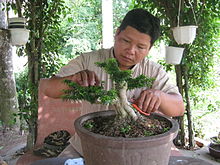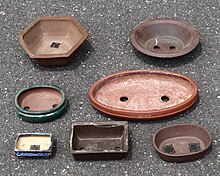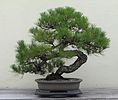bonsai
(jap. 盆栽) is the Japanese variant of an old Far Eastern type ofgarden art, in which shrubs and trees are grown in small containers or in the open to limit growth and aesthetically shaped. This art form probably originated inChina, where itiscalledpenjing.
Another form are the miniature living landscapes by the Vietnamese Hòn Non Bộ . Independent traditions, which are usually also referred to as bonsai , exist in the Indonesian region, for example on Bali . In the west, variants are developing that are primarily based on the inclusion of native species ( olive trees in Italy and Spain, ponderosa pines in the USA).
Definition
The Japanese word bonsai ( 盆栽 , dt. "Planting in the bowl") goes back to the Chinese term 盆栽pénzāi . An aspect within the art form of penjin was named ( Chinese 盆景 , Pinyin pénjĭng - "landscape in a shell" ( 盆 , pén - "shell", 景 , jĭng - "landscape, scene")). The word bonsai consists of the two words bon “bowl” and sai “plant”.
According to the old Chinese understanding, penjing is the art of depicting harmony between the natural elements, living nature and humans in miniaturized form: living nature is usually represented by a tree . The forces of nature represent - after another expression for landscape 山水 , shānshuĭ - "(literally) mountain and water" - a stone and fine gravel (which traditionally symbolizes water in gardens ). Man is represented in the form of his work, a planter . Only the harmony of these three elements makes a successful penjing. A distinction is made between:
- shumu penjing , tree penjin. Here a single tree or a small group stands in a bowl without any other elements.
- shanshui penjing , landscape penjin. The tree can play a secondary role here; what is important is the depiction of a miniature landscape, usually made of naturally shaped stones, which is also decorated with herbaceous plants or moss.
- shuihan penjing , water and land penjin. Sand is also used to represent a watercourse, a pond or lake surface. Often there are also rocky landscapes that stand on flat trays that are filled with water.
Penzai only partially correspond to shumu penjing , as the boundaries between these terms are fluid anyway. The figure at the top of the article can definitely be referred to as penzai , but also as shanshui penjin , since the stone can be interpreted as a rocky dome.
In Japan the focus of landscaping shifted entirely to tree design; The term saikei does exist, denoting miniature landscapes with small wooden plants, but these by no means have the status of the Chinese penjin. Garden trees are also designed according to the formal criteria of bonsai.
history
The bonsai known today are often designed in the Japanese style that emerged at the beginning of the 20th century. But the art of bonsai is much older and comes from the garden art of the Chinese Empire .
China
In the early Han dynasty (206–220 AD), artificial landscapes with lakes, islands and bizarre rock formations were recreated in palace gardens of the emperors, and the potted plant culture was already known. According to mythology, the magician Jiang-Feng lived at this time, who had the ability to conjure up entire landscapes with rocks, water, trees, animals and people on a tray. The art of penjing evidently emerged during this time - even if some of the trees were two or more meters high and were tended in large bowls in the garden.
In the Tang Dynasty (618–907), the oldest known depiction of a penjing, a miniature landscape with delicate trees and rocks, can be found in the burial chambers of Prince Zhang Huai. This era was considered to be very artistic, poets and painters turned to nature in particular.
The Song Dynasty (960–1279) brought the Penjing culture to its first bloom. Gnarled trees, especially pines that were grown from tree roots, were now particularly popular. At the same time, the art of suiseki developed , which manages without trees and places beautifully shaped stones on trays filled with water. This creates impressions of coastlines or dramatic rock landscapes in the high mountains. The contemporary book Yunlin Shipu lists 116 types of stone that can be used for design.
Miniature penjing were particularly popular in the Yuan Dynasty (1280–1368). The principle of “seeing the great in the small at the same time” (He-Nian, a poet, wrote a series of poems about the “tiny” penjing of the monk Yun Shangren, from which the quote) became an important guiding principle in the centuries that followed.
Since the end of the Ming dynasty (1368–1644), individual trees and bowl landscapes are probably first referred to as penjing . A number of books were written during this period. The Chinese landscape painting, which was very popular at the time, gave Penjing art new impulses. They were referred to as “three-dimensional paintings”, “silent poems” or “living sculptures”; they were usually around half a meter tall, so that they could still be placed on a tea table - then they were considered particularly precious.
In the Qing Dynasty (1644–1911), bonsai gradually penetrated the country's noble families, who often hired their own penjing gardeners. Every year in Suzhou there was a competition for the most beautiful trees in the country. It was found that the different regions had developed different styles:
- Lignan style (Guangzhou)
- Shanghai School
- Suzhou School
- Yangzhou School
- Sichuan school .
It is said that whoever has successfully grown and cared for a bonsai does not have to worry about the well-being of his soul after death.
Japan

In 10./11. In the 19th century, Buddhist monks brought the art of bonsai to Japan. There the bonsai style developed parallel to China for a long time.
In the Edo period , the fashion of cultivating plants and trees in pots experienced a strong boom, not least due to the example of the shogun Tokugawa Iemitsu (1604–1651). At that time, mainly plants were collected whose flowers and leaves had produced conspicuous mutations and so did not occur in nature. Many of these trees had curves and bends that appear unnatural today ("octopus style", some specimens from the Iemitsu collection have survived to this day). These rare plants soon became objects of speculation , much like the Dutch tulip fever .
Towards the end of the Edo period, the shogunate began to falter. Especially the Bunjin (Jap. 文人 , chin. Wénrén "man of words", but usually with " writer " translated) did from Kyoto and Osaka from as organizers of demonstrations and other anti-monarchist actions produce. They also turned against the very artificial bonsai culture of that time, and due to their preoccupation with Chinese painting and literature , they found a new style, the Bunjingi (the name is based on the " literary style " of Chinese art) . They preferred native species such as pines and maples and took nature as a model for their designs. In the art theoretical literature of that time (for example in the Chinese mustard seed garden , in Yuo Hikusai-gafu and in Kaishi-en-kaden ) the styles known today such as Kengai and Chokkan were already formulated. Especially in the imperial city of Kyoto and in Osaka, the style was very popular with scholars and was considered anti-national and avant-garde.
While the rulers pursued a policy of isolation and a trip to China was forbidden on the death penalty, Japanese scholars formed their own little China out of rocks and plants. The trees became more and more an expression of their idea of a life in which one can uncompromisingly realize one's ideals.
At the beginning of the Meiji period , Tokyo's upper class also discovered their love for bonsai. The design ideal, however, was no longer the shape of naturally growing trees, but their proximity to Chinese painting. Bonsai were exhibited in teahouses and gradually reached the lower classes of the population. After the victory in the war against China and Russia , they again embodied the spirit of the revolutionary in a climate of nationalism imposed from above and finally advanced to an art form that was also shown at exhibitions. The aim was to "create a work of art that is more natural than nature itself, always using the beauty of nature as a model". Towards the end of the Meiji period, the design ideal that is still valid today was formed, according to which Bunjingi should have a high, curved trunk and few branches.
In 1867, Japan presented bonsai to a Western public for the first time at the World Exhibition in Paris .
After the Second World War, bonsai became a hobby all over the world.
Bonsai cultivation
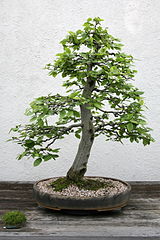
|
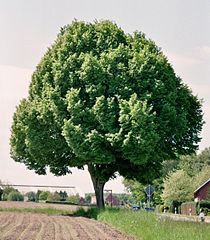
|
|
|
The common hornbeam ( Carpinus betulus ) as a cultivated bonsai and as a free-standing specimen near Ibbenbüren , North Rhine-Westphalia
|
||
The bonsai is a drawn in a planter tree obtained by cultivation measures ( topiary , root pruning , leaf section , wiring ) is kept small and in artistic design in a desired growth form is brought. This follows the principles of Wabi and Sabi of Zen culture and the - partly Confucian , partly Taoist influenced - tree representations of classical Chinese painting . In Japan , bonsai are set up in the garden or in the tokonoma , a highlighted niche in the room. With good care, bonsai trees can be hundreds of years old and very valuable. In the West, bonsai is generally only understood to mean the bonsai tree . Bonsai, embedded in a view of nature and the world in Japan, is reduced to the formal and aesthetic . The cultural background of the Japanese role models is perceived and reflected to different degrees, but overall it plays a subordinate role.
Species of wood for bonsai

|

|
|
|
Deciduous trees :
Toringo apple ( Malus toringo ) during the vegetation period and after the leaf fall |
||
Almost all woody, small-leaved or small-needle tree and shrub species are suitable for bonsai.
Traditionally, in Japan pines ( e.g. white pine , Pinus parviflora ), junipers , maples ( tricorn maple , Acer buergerianum , and Japanese maple , Acer palmatum ), Asian elm species (especially the Chinese elm , Ulmus parvifolia ), azaleas , Fruit trees such as cultivated apples or Japanese apricots ( Prunus mume ) are used.
In Central Europe, native woody plants that are adapted to the regional climate are mainly used, but also imported hardy plants from Japan and other countries. Small-leaved maples - including the red-leaved Japanese maples - as well as pine, spruce , beech and juniper are popular . However, native bonsai, especially smaller specimens, are protected from severe frosts by, for example, sunk into the ground or covered with a layer of mulch . Even frost in the air could lead to the contents of the shell freezing through, on the other hand trees in nature rarely stand in permanently frozen ground.
As part of the dissemination of bonsai culture in western culture bonsai techniques were also on woody houseplants (English indoor plants transferred), so today between indoor and outdoor is distinguished. The culture of indoors is problematic, because you can hardly offer them the urgently needed living conditions (continuously 2000–3000 lux 12 hours a day, humidity at 70–90 percent at a temperature of around 15–30 ° C) in normal households As a result, plants become sick or die. Experience has shown that the indoor culture of Fukientee ( Carmona microphylla , also known as Ehretia microphylla or Ehretia buxifolia ) and June snow ( Serissa foetida ) is difficult . Only small-leaved species of the genus Ficus have proven to be so robust and adaptable that they can easily be kept as indoor bonsai . Today they are considered the typical beginner plants.
Bonsai can be formed from seedlings, young plants and plants (yamadori) collected in nature. Nursery plants or container plants from the garden center are often also suitable . Genetically, bonsai trees are no different from ordinary plants. Therefore there are no bonsai seeds. The bonsai tree retains its characteristic size through the cultivation measures alone.
Erratic boulders or yamadori
In addition to propagation from seeds , cuttings or the further development of tree nursery plants, there is also the possibility of digging up trees, so-called boulders. Particularly wild-looking trees (for example from the high mountains) are called Yamadori . Relocating an old plant can be complex and requires experience, but this type of raw plant production can lead to particularly beautiful and interesting bonsai.
Before appropriating a boulder, the permission of the landowner or the respective owner must be obtained and, if necessary, environmental protection aspects must be clarified. Digging up a tree without permission from the owner or owner is illegal ( forest crime ) and can be prosecuted both criminally and civilly. In the West, the ecological consequences of the Yamadori search are still negligible, whereas in Japan entire areas were plundered in this way for a long time (e.g. by junipers).
Miniature Bonsai / Mame
Mame bonsai are only a few (at most 20) centimeters tall. This type of bonsai requires many years of experience as it is much more difficult to care for such bonsai (risk of drying out, difficulties in shaping). Most of the time you cannot keep this form of bonsai in this size for very long, often they are then developed into larger bonsai.
"Department store" bonsai
For some years now, indoor bonsai has also been offered in flower shops, department stores and hardware stores . In keeping with the low price, these trees usually have strong aesthetic compromises, e.g. B .:
- In order to achieve a strong trunk, a nursery tree was cut and the top branch continued as a trunk. In the case of cheap copies, this is done in an inharmonious manner; the branches hardly hide the interface.
- The branches show indentations or even scars due to the infrequent adjustment of the wiring.
- It happens that wires have grown in.
- Often there is a lack of stylistic aspects that are important for the overall aesthetic and natural appearance of the bonsai, such as: B. a well-considered three-dimensional branch arrangement as well as maintaining the basic proportions of the individual branches for the overall appearance of the tree. The shell sizes used often deviate from the classic specifications, such as B. "Depth of bowl approximately equal to trunk diameter", this can lead to the fact that the bonsai looks more like a normal houseplant with an oversized bowl.
- Occasionally the plants are not “real”, but replicas.
Design guidelines
When it comes to the design of the bonsai, there are different and sometimes contradicting views of the individual style elements, which relate in particular to the trunk shape, the arrangement of branches, fine branching and the matching bowl. Different points of view in different regions and epochs as well as inconsistent guidelines of numerous associations and clubs led to the different design guidelines for bonsai. What they generally have in common is that a bonsai should appear as a living, three-dimensional sculpture, either like a miniaturized free-growing tree or a stylized interpretation of such a tree.
The established design guidelines for bonsai are often of decisive importance in competitions and for determining financial value. The overall appearance and individuality of the tree is also of great influence within the framework of the design rules. Many excellent and expensive bonsai, on the other hand, show only limited adherence to the strict design guidelines, but impress with their uniqueness and complexity, which is often only possible without taking the basic rules into account. The design rules for bonsai are often and controversially discussed in the specialist literature and in associations.
Design measures
Basic cut and maintenance cut
The first cut is the design or basic cut . Here you determine the design form. A denser branching is sought in the maintenance cut. A regular cut ensures compact growth, fine branching and sufficient density.
The shoots that grow out of the form are taken back. If little pruning is done, less growth is stimulated than with a rare but strong pruning. The respective new growth depends largely on the season. Native species mostly sprout in spring or June. When old branches are removed, known as perennial wood, so-called dormant buds in particular are stimulated to sprout, which causes renewal from the inside of the treetop.
Removing the taproot promotes the branching of the root ball so that a fine, even root system is formed.
The location of the plant is also important. In too dark a location it will produce long shoots , the so-called stretch shoots. Usually there are hardly any compromises with regard to the light needs of the individual species.
Wiring
Apart from the traditional method of “cutting back and letting it grow”, the branches can also be shaped using tension wires. Traditionally, palm fiber cords were used.
Today the method of wiring is mostly used . To do this, the trunk, branches or twigs (depending on which part of the tree you want to correct) are wrapped spirally with anodized aluminum or annealed copper wire and carefully bent into shape.
Leaf cut
By a sheet cut one, artificial autumn 'is simulated. It is used particularly in strong-growing areas of the tree in order to encourage it to develop more side shoots and to promote fine branching. In addition, the newly sprouted leaves are usually a bit smaller and therefore look more harmonious with the size of the bonsai.
To protect the bud , the stem is left in the leaf axil . When the bud shoots, the stem falls off later.
Debarking
By debarking trunk or branch parts (called Shari for trunk parts , or Jin for branch stumps) the bonsai gets the appearance of an aged tree.
The exposed wood can also be further processed and shaped with tools such as knives , milling cutters and chisels . Most of the time, the processed areas are finally treated with a preparation based on sulfur lime . The agent is used for sterilization and for bleaching the surfaces.
Mossing
The so-called mossing “shortens” the trees. For this purpose, the bark of a plant part, z. B. a branch, except for the cambium in a 2 to 4 cm wide strip peeled off in a ring. Then the bark-free ring is wrapped with a substrate and a film and regularly moistened. After the formation of the root material, the relevant plant part can be separated and further cultivated as an independent plant.
Plates
By attaching branches or twigs, preferably to the trunk of the original plant, branches and twigs can be added to a selected part of the plant.
Bowl
What the frame is to the picture, the bowl is to the bonsai. So it represents a further essential component of the total work of art bonsai and must be selected carefully and individually for each tree. In some cases a bowl is handcrafted especially for a tree. For dignified old pines in the upright style, for example, rectangular bowls in unglazed earth tones are ideal, for flowering or delicately built trees one would choose round or oval shapes in light tones. Cascades and half-cascades grow in deeper bowls, otherwise the visual balance is not right and the tree seems to tip over. Round bowls (so-called drum bowls) are often used for literary forms. When choosing the bowl, it should be noted that this should not be the focus, but the bonsai. A bowl that is "too beautiful" or too conspicuous will distract from the bonsai and therefore does not serve its purpose. Exceptions are the smallest bonsai, Mame : Here very colorful and eye-catching pots are used with preference.
Presentation table

Bonsai tables as a style element of the overall conception of tree, bowl and table have a mainly aesthetic function. The task of the bonsai table is to present the bonsai higher than the given surface, which on the one hand gives the bonsai additional grandeur, grace and formality as well as a stronger character, but on the other hand can also improve the view of the tree.
maintenance
Compared to other ornamental plants, there are some differences in bonsai care that must be taken into account in order to keep the bonsai properly.
Limited root space
Since the root growth is limited by the bonsai pot, the tree has little room for the formation of additional roots. In order to obtain sufficient growth, however, much more intensive fertilization is necessary. If classic soil mixtures are used instead of modern mineral substrates, a precisely controlled water supply corresponding to the tree species is necessary, as the limited volume of soil stores only little water or excessive watering is only intercepted to a limited extent, so that the risk of root rot or fertilizer-related salination of the soil mixture consists. Therefore the use of mineral substrates is on the rise.
Pests and diseases
The consequences of an infestation such as B. leaf or branch losses are more significant than with larger plants due to the tree size and the detailed design. The early and professional control of the infestation is particularly important here, although failures can sometimes also be used as a design feature.
Setting up the bonsai
Tokonoma
The traditional exhibition situation in the Tokonoma includes: a scroll painting in the background that adds another dimension to the tree (pines go with calm mountain motifs, maples also include animal scenes), a small table or a lacquered tree disc and an "accent plant" that acts as a counterpoint and deepens and supports the theme of the scene (mostly grass, bamboo , small shrubs in a shallow bowl). This type of installation also results in the choice of a front (viewing side) of the bonsai, which is required in the Japanese design style.
On the year in Tokyo held th Kokufu- the biggest bonsai show in Japan, will be awarded the best trees in the country since the 1933rd Even the invitation to the exhibition is considered a great honor.
European exhibition situation
In Europe, however, bonsai are usually not set up in tokonoma. A selected front is therefore often less important, as are the accompanying decorations that are common in Japan (so-called side plates, small figures and scrolls). Similar to Chinese and Japanese gardens, trees are designed that can be viewed from all sides. In many exhibitions, however, a traditional scheme still dominates, the trees are presented on tables lined up in a row in front of partitions.
Form science of the Asian bonsai style
The Asian forms of bonsai design are derived from almost two thousand years of tradition that are still used today. In the course of the 20th century, today's design forms for the bonsai developed. However, this is mainly true of Japanese bonsai.
In the European bonsai design, after an initial phase of the pure adaptation of Japanese design language, focal points gradually developed: In addition to the advocates of a traditional design concept, a "naturalistic bonsai design" has developed, in which the bonsai trees should look as similar as possible in the wild. There are also designs that are influenced by Chinese Penjing, and occasionally experimental, artistically free designs.
The design goals differ significantly: While the Japanese style conveyed in Europe mainly aims to adhere to certain formal requirements (see below), the naturalistic style focuses on the design of interesting, natural forms. In contrast, artistically free works use the bonsai as a design element in a wider context. In all cases, the bonsai is designed intensively, but with a different focus.
The Japanese design forms are defined below:
The upright form
Chokkan
Moyogi
Kabudachi, multiple stem
Sōkan
Another variant is also the triple stem ( 三 幹 , sankan ) or "father, mother and son".
Netsuranari
Air forms
Shakan
Fukinagashi

|
The Fukinagashi ( 吹 流 し , German "small body" or "streamers") - "windswept form" - stands in the stormy wind. The role models for this type of design are wind evacuators , which can be found on coasts, in steppe landscapes or on mountain ridges, for example. Usually, the branches and twigs in a windswept bonsai are almost exclusively guided in one direction away from the trunk. The direction of inclination of the trunk usually determines the direction in which the branches are shaped. Bonsai of this form are supposed to embody a certain tragedy, which is essentially based on the origin of their great role models in nature. This can be emphasized or reinforced by the technique of debarking, for example. A Fukinagashi can, for example, be created from a bonsai with a straight, or even better, an inclined trunk, or it can be further designed. |
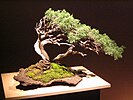
|
Han kengai
Kengai
Character forms
Bankan
Bunjingi, literary form

|
Bunjingi ( 文人 木 , dt. "Literati Tree") is the traditional Japanese bonsai shape (see history: Japan ). Bonsai in Bunjingi shape are characterized by a tall, thin and usually elegantly curved trunk, few branches and sparse foliage. The appearance or the shape of a bonsai designed as a Bunjingi does not necessarily have to refer to a model in nature, but can rather be equated with a personality full of character and poetry itself. Particularly aesthetic Bunjingi are often assigned poems or verses, or a poem or verse is only written for a single tree. Bonsai designers and artists consider the design of a bunjingi to be the mastery. The shape looks very simple and straightforward, but that's where the difficulty lies. Because the tree has so few elements, they all have to be consistent. Errors cannot be hidden. At the same time, it must look like an old tree with maturity. The demands on material and design are correspondingly high. |

|
Ishi-Tsuki, rock form
Sekijōju
Further growth peculiarities
Hokidachi

|
Hokidachi ( 箒 立 ち , German straight upright shape (broom shape)) is often found in European deciduous trees and is characterized by a short, straight trunk, from which all branches branch off in a star shape at approximately the same height and evenly become a round or uneven one triangular crown branch. The base of the trunk is even and pronounced. Trees that are often found in this form are zelkova , hornbeam and maple . |

|
Neagari
Nebari in the meaning of the root of the trunk
Ikadabuki
Yose-ue, the forest
The tools
A large number of specialized tools have emerged over the years for designing and maintaining the shape of bonsai. The most common are:
- Abmoos discs: are z. B. filled with moist sphagnum moss and used for mossing
- Pruning saw: for removing larger branches, such as freshly dug yamadori
- Leaf cutter: for cutting fine twigs and shoot tips ( pinching ) as well as for cutting leaves
- Bonsai brooms: for working on the surface of the earth (e.g. after repotting )
- Wide scissors: for topiary cuts (silhouette) and smaller knots
- Wire cutter: for removing the wire piece by piece from wired branches
- Wire cutter: for better joining of particularly strong wires
- Earth shovel: in various sizes and some with built-in sieve (which sifts out too fine components that could hinder the aeration of the substrate); serves for the selective filling of the bonsai pot when repotting
- Wooden or bamboo stick: for bringing in and consolidating the earth when potting. This ensures that no cavities are created when the tree is potted
- Jinzange: for peeling off the bark in jin / shari design (artificial aging) or for unwinding wire
- Jin knife: for scratching the bark, which can then be peeled off with the jin pliers
- Concave pliers: for cutting thick branches. Due to the curvature of the cutting edges, it leaves a concave cut, the callus (wound tissue) can better cover the cut
- Bud pliers : also called round concave pliers, have the same function as concave pliers, but are better suited if you can only cut at an unfavorable cutting angle
- Narrow scissors: because of the long, narrow neck for fine cutting work, e.g. B. young shoots inside the crown
- Sickle knife: can be used to loosen the soil ball from the edge of the bowl when repotting
- Splitting pliers: for breaking out branches and trunk parts
- Root hook or claw: is used to loosen or dismantle the root ball when repotting. By loosening the ball, the roots can be drawn longer and then shortened. It can also be used to loosen the root area directly under the trunk and later bring in the fresh soil better
- Root tongs: for cutting (thicker) roots
- Nigiri scissors: tweezers-like scissors with knives on the front are used for cutting leaves
See also
literature
On-line
- Michael Tran: Dorling Kindersley: Happy Bonsai: Choose It, Shape It, Love It (DK) . Dorling Kindersley, 2020 ( archive.org [accessed May 1, 2020]).
- Bonsai Art journal
Books
- Bernd-Michael Klagemann: Bonsai - harmony between man and nature. bioverlag Gesundheitleben, Hopferau 1983, ISBN 3-922434-89-4 .
- John Yoshio Naka: Bonsai Technology Volume 1. Bonsai Centrum, Heidelberg 1985, ISBN 3-924982-00-7 .
- Lesniewicz, Zhimin: Penjing, miniature trees from China. BCH, Heidelberg 1986, ISBN 3-924982-02-3 .
- Pius Notter: Bonsai Art and Technology, Basilus, Basel 2nd edition 1989, ISBN 3-85560-092-9 .
- Horst Stahl: Bonsai - From the basic course to the master. Double volume, Kosmos, Stuttgart 1992, ISBN 3-440-08875-8 .
- Werner M. Busch: Bonsai from local trees and shrubs. BLV, Munich 1993, ISBN 3-405-14455-8 .
- Benz, Lesniewicz: Chinese Bonsai, Penjing. BLV, Munich 1994, ISBN 3-405-14447-7 .
- Wolf-D. Schudde: Giving the tree a voice - The art of bonsai design. Media Verlag Wolf-D. Schudde, Düsseldorf 1995.
- Wolf-D. Schudde: European Bonsai - On the way to the next millennium. Media Verlag Wolf-D. Schudde, Düsseldorf 1998.
- Lesniewicz: Bonsai miniature trees . BLV, Munich 1998, ISBN 3-405-13693-8 .
- Pius Notter: A life for the tree. The art of designing trees, Fischer Media Verlag, Münsingen-Bern / Switzerland 1998, ISBN 3-85681-309-8 .
- Pius Notter, Georg Reinhard: Bonsai for beginners. Care and design. Fischer Media Verlag, Münsingen-Bern / Switzerland 1999, ISBN 3-85681-338-1 .
- Horst Daute: Bonsai. BLV, Munich 1999, ISBN 3-405-15338-7 .
- Manfred Roth: Bonsai master school. Naturbuch-Verlag, Augsburg 2001, ISBN 3-89440-290-3 .
- Red Canzian: Bonsai. Unipart, Stuttgart 2004, ISBN 3-8122-3394-0 .
- Harry Tomlinson: The BLV Bonsai Handbook. BLV, Munich 2004, ISBN 3-405-14850-2 .
- John Yoshio Naka: Bonsai Technique Volume 2. Bonsai Centrum Gessner, 2007, (reissued), ISBN 978-3-924982-09-6 .
- Johann Kastner: Bonsai - step by step to becoming a bonsai professional. Gräfe and Unzer, 2nd edition Munich 2010, ISBN 978-3-8338-1126-5 .
- Manfred Roth: Where silence lives - the source of life, nature, edition Vernissage, Heidelberg 2010, ISBN 978-3-941812-02-4 .
- Werner M. Busch, Achim R. Strecker: Bonsai - design with native trees. A practical manual for beginners and advanced users. Quelle & Meyer, Wiebelsheim 2014, ISBN 978-3-494-01560-6 .
Web links
- Link catalog on the topic of bonsai at curlie.org (formerly DMOZ )
- Bonsai glossary (multilingual)
Individual evidence
- ^ Walter Pall: Substrate, water, fertilizing. January 2012 accessed June 3, 2013 .
- ↑ bonsai by Walter Pall. Retrieved June 4, 2013 .
- ↑ Penjin specialist article in the forum artofbonsai . Retrieved June 11, 2014.
- ↑ A Gallery of Bonsai by Nick Lenz Technical article in the forum artofbonsai . Retrieved June 11, 2014.







